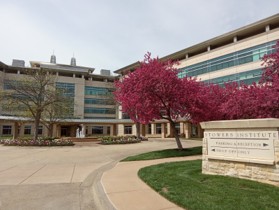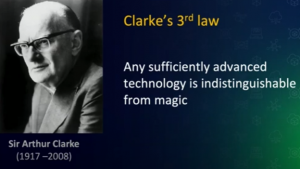The Magic of Biocuration: Biocuration 2025 in Kansas City

The Biocuration 2025 meeting held in Kansas City USA at the Stowers Institute (April 5-9) was a well organized blend of in-person and virtual participants. As regular attendees and International Society of Biocuration (ISB) members (see previous reports) GigaScience Press was represented by two members of the GigaDB team, Chris Hunter and Bastien Molcrette.

The first two days saw multiple concurrent workshops, mostly hands-on with lots of great content. The main 3 days of the conference were held as a single track allowing everyone to engage on the same topics during the breaks and networking times. Chris presented twice during the meeting, firstly giving an update of GigaDB, in addition this was presented as a poster. Chris’ second presentation was about the Genomic Standards Consortium (GSC) including a plug for the upcoming GSC25 meeting to be held in Cambridge UK, in July.
The presentations were recorded and have been posted on YouTube here for anyone who wants to watch them back. Chris’s presentations were in Day 1 Session 1 on “Encouraging authors to use and cite data in public repositories; a publisher perspective.“.
The second talk on Day 3 Session 1 was entitled on “How have standards in genomics evolved since the first microbial genome was published 3 decades ago?”. This talk representing GSC and covering a lot of the ground that our 10th birthday Commentary from Lynn Schriml on the history of the GSC presented.
As with many conferences at present, there was a running theme of “AI”, what is already being done with it and what more it could potentially be used for in relation to biocuration. There is a lot of optimism balanced with a healthy degree of skepticism within the biocuration community. Biocurators are definitely key in the generation of “gold standard” datasets for training purposes, as well as validation. There is a general consensus that for the foreseeable future the AI tools will be evolving rapidly and therefore will still require a great deal of expert curators to guide and assess. The hope is that AI tools can be developed to increase curator efficiency by reducing the time spent on discovery of relevant documents and information.
Nirav Merchant (University of Arizona) gave an entire keynote presentation around his vision of AI where the A stands for “Augmented” rather than artificial. To quote Nirav “If we design machines to complement us, then we are free to emphasize features that are most useful”, in other words dont be afraid of AI taking over everything, but there are definitely tasks that it can do very well that we can and should be making use of. He also reminded us of Clarke’s 3rd law “Any sufficiently advanced technology is indistinguishable from magic”, then proceeded to engage the audience with a hands on AI training experiment utilising the Google Teachable Machine, which was a lot of fun.
 The keynote by Sam Stevens (The Ohio State University) entitled “Imageomics: Images as the Source of Information about Life“ was about the potential of AI in the field of image analysis, with a variety of examples of the sorts of counting from images that can now be easily automated by AI techniques to recognise objects within images, even public wildlife photographs not taken in a research environment. Species recognition is becoming increasingly more accurate as larger numbers of curated training datasets are made available. Perhaps it would be interesting for someone to run one of those algorithms over the camera trap dataset we host in GigaDB (DOI:10.5524/100191) from the Nobel et al,. 2016 paper published in GigaScience.
The keynote by Sam Stevens (The Ohio State University) entitled “Imageomics: Images as the Source of Information about Life“ was about the potential of AI in the field of image analysis, with a variety of examples of the sorts of counting from images that can now be easily automated by AI techniques to recognise objects within images, even public wildlife photographs not taken in a research environment. Species recognition is becoming increasingly more accurate as larger numbers of curated training datasets are made available. Perhaps it would be interesting for someone to run one of those algorithms over the camera trap dataset we host in GigaDB (DOI:10.5524/100191) from the Nobel et al,. 2016 paper published in GigaScience.
To round off the theme of biocuration being an important part of the AI research environment, the Biocuration 2025 keynote of Andy Hickl (Allen Institute) said the use of AI is leading “to an unprecedented era of machine-assisted scientific sense making”. At GigaScience we strongly agree with this message, and have done our best to work machine-learning standards into our biocuration processes. We look forward to seeing how this era progresses at future meetings.